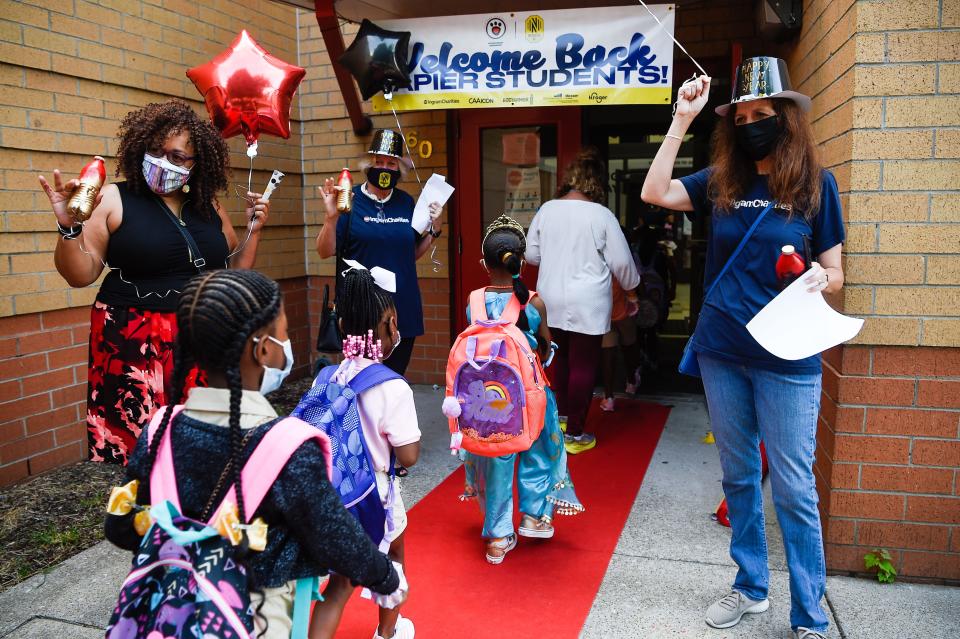Learn from experience: Don’t close schools for omicron surge | Opinion
- Oops!Something went wrong.Please try again later.
With the newest variant of COVID-19, omicron, surging through the world, some call for once again closing down physical schools. This strain of COVID is much milder than previous variants, and most who are infected experience symptoms akin to those of the common cold, if any at all.
Some school and union leaders are beginning to recommend school closures to combat the recent increase in cases. Fortunately, most school districts are moving forward with in-person learning.
Epidemiologists' declaration

Way back in October 2020, Drs. Martin Kulldorff, Sunetra Gupta and and Jay Bhattacharya — epidemiologists from Harvard University, Oxford University and Stanford University Medical School, respectively — penned what became known as the Great Barrington Declaration. In it, they declared that reasonable efforts should be taken to protect against COVID-19, including protecting the most vulnerable and practicing good hygiene. Since becoming available, they have supported vaccines, especially for the those most vulnerable to the virus.
The declaration rejected the notion that widespread lockdowns and school closures would end the pandemic. Instead, they suggested that those drastic measures were doing more harm than good. They stated that the lockdowns were damaging to individuals’ mental and physical health, particularly children, and disproportionately harmed the least fortunate. More than a year later, we now know that Kulldorff, Gupta and Bhattacharya were correct, especially when it comes to schools.
My new book, "COVID-19 and the Classroom: How Schools Navigated the Great Disruption," details how schools reopened, both here and abroad.

Your state. Your stories. Support more reporting like this.
A subscription gives you unlimited access to stories across Tennessee that make a difference in your life and the lives of those around you. Click here to become a subscriber.
Schools in East Asia and Europe reopened much earlier
Compared to the United States, schools in East Asia and Europe were much more likely to offer in-person schooling. Most countries reopened their schools by June 2020, just months into the pandemic. Meanwhile in the United States, some school districts did not offer in-person learning options for the entire duration of the 2020-2021 school year.
Hear more Tennessee voices: Get the weekly opinion newsletter for insightful and thought-provoking columns.
Policymakers can be forgiven for the initial school closures. In March 2020, much was unknown about COVID-19, so closing schools was a prudent protective measure. However, school closures have been an ineffective mitigation strategy. Research from around the globe has found little relationship between closing schools and curbing viral spread.

School closing policies rested on a flawed assumption that students would either attend school as usual, or they would be quarantined alone in a room with no contact with others. In many cases, school closures made it more likely that children would attend daycare facilities or be with older, more vulnerable adults.
While the benefits are highly uncertain, the damages from closing schools are increasingly apparent, particularly for the most vulnerable children.

A recent study suggests that students’ math achievement fell 14 points last year; however, students who attended in person saw their scores fall only 4 points. Evidence also suggests that students who participated in remote schooling suffered socially and emotionally, just as predicted by the Great Barrington trio.
The gaps were not as dramatic for reading scores, but achievement gaps widened for students of color and for the economically disadvantaged. To quote the Great Barrington Declaration, “keeping students out of school was a grave injustice.”
Sign up for our newsletter: Read compelling columns by Black writers from across Tennessee.
Remote learning options are likely here to stay beyond the pandemic for families who choose it. They may even make sense as a very short-term option when too many teachers are out due to COVID-19 or another crisis emerges. But overall, these should be employed on a limited basis.
Given the benefit of hindsight, school leaders in Europe and elsewhere who elected to reopen schools in mid-2020 were correct to do so — and they did so amidst a more challenging strain of the virus and without the benefit of vaccines.
Those who fail to learn the lessons of history are doomed to repeat them. School closures have been an ineffective mitigation measure and have simultaneously led to adverse health and learning outcomes for too many young Americans during the pandemic.
Policymakers should learn the lessons from the past two years and keep schools open.
David T. Marshall is an assistant professor of educational research at Auburn University and is the editor of "COVID-19 and the Classroom: How Schools Navigated the Great Disruption."
This article originally appeared on Nashville Tennessean: Learn from experience: Don’t close schools for omicron surge

